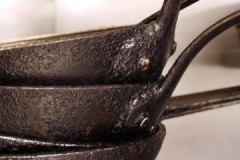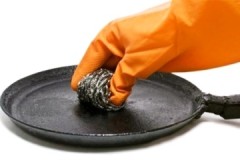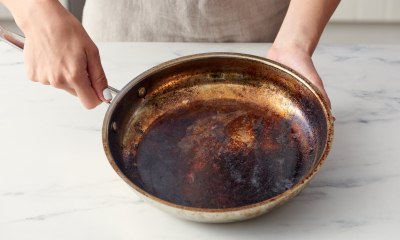 Soot is the result of daily use of the frying pan. Small drops of boiling oil, particles of burnt food, open flames of gas burners - all this contributes to the rapid growth of brown deposits on the walls of dishes.
Soot is the result of daily use of the frying pan. Small drops of boiling oil, particles of burnt food, open flames of gas burners - all this contributes to the rapid growth of brown deposits on the walls of dishes.
Lack of regular maintenance leads to the frying pan being covered with a thick layer of soot, the removal of which requires a lot of effort and time.
We'll tell you in this article how to clean a frying pan from old, thick, black carbon deposits inside and outside at home.
Content
How to remove carbon deposits using folk remedies?
There are a sufficient number of methods for cleaning pans. But only some people are able to cope with the frozen layer of fat.
TOP – 3 most effective folk ways to combat soot on a frying pan:
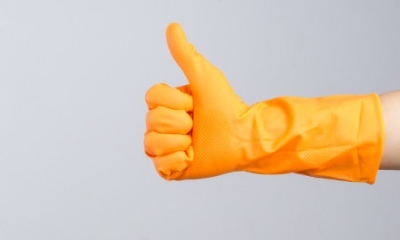 Baking soda and hydrogen peroxide. The ingredients are mixed to form a thick paste, which is used to coat the soot in the frying pan. After ten minutes, adhered layers of fat can be easily removed with a hard sponge or brush.
Baking soda and hydrogen peroxide. The ingredients are mixed to form a thick paste, which is used to coat the soot in the frying pan. After ten minutes, adhered layers of fat can be easily removed with a hard sponge or brush.- Soda and table vinegar - a universal remedy in the fight against old fat on the walls of the frying pan. Pour vinegar and water into the bowl (in equal proportions), bring the solution to a boil. After removing the pan from the heat, add 1 tbsp to the hot water. soda (the mixture should sizzle). The result of the manipulations: the old and thick layer of carbon deposits can be easily cleaned off with a soft sponge.
- Activated carbon. It's simple: grind ten tablets into powder, add 750 ml of water, and bring to a boil in a frying pan. After boiling the mixture for ten minutes, wipe the contaminated surfaces of the frying pan with a sponge moistened with dishwashing liquid.
If cleaning with improvised means does not lead to the desired result of cleanliness, you need to repeat the procedure using chemical compounds.
How to remove fumes using household chemicals at home?
Special chemicals (available in an assortment on the shelves of hardware stores), when used correctly, work wonders, very quickly returning fried, smoked pans to their original appearance.
TOP – 3 most effective means for cleaning frying pans from carbon deposits:
Bagi grease remover Schumanit
An effective, concentrated product, which removes stubborn fat deposits from pans in a matter of minutes. It is enough to spray Schumanit on the contaminated surface, wait 1-2 minutes, after which the grease is easily washed off under running water.
The spray nozzle helps you use the cleaning product economically. The average cost is 470 rubles. (400 ml bottle).
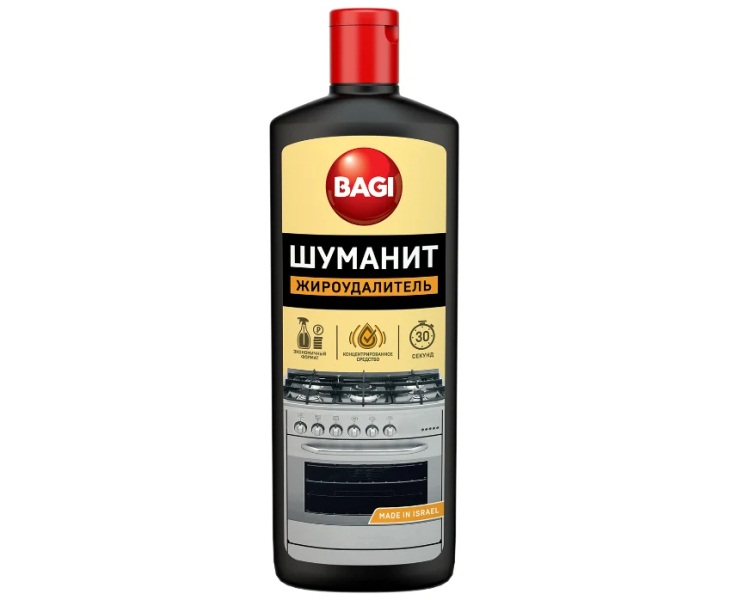
Sanita gel Multisil
Easily removes:
- old fat,
- soot,
- soot,
- leftover burnt food from frying pans.
Simply apply the product to the contaminated surface, leave for ten minutes, then rinse with warm water. Not suitable for aluminum cookware. The average cost is 110 rubles. (500 ml bottle).
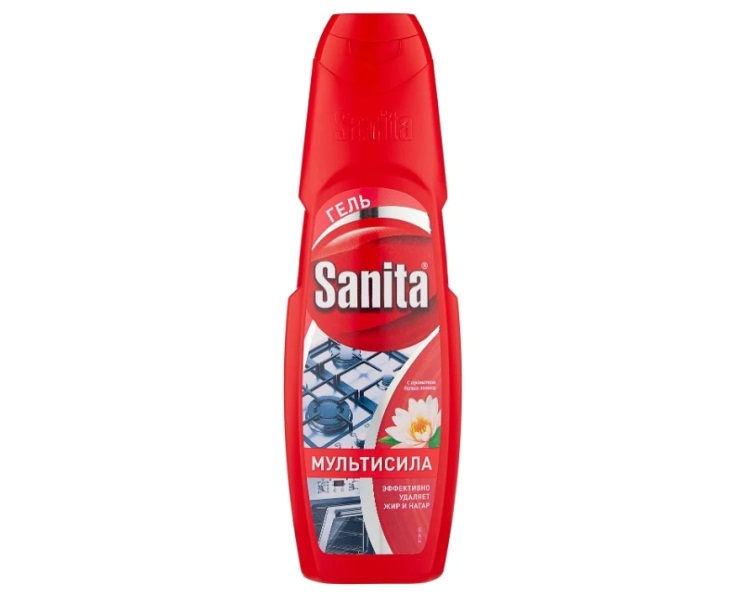
Gallus
This stove and oven cleaner will remove stubborn grease and burnt food from pans, pots and ovens. Destroys persistent unpleasant odor of fat.
The gel is applied to the contaminated surface, left for five to ten minutes, after which the frying pan is wiped with a damp sponge or washed off under warm running water. The average cost is 250 rubles. (750 ml bottle).
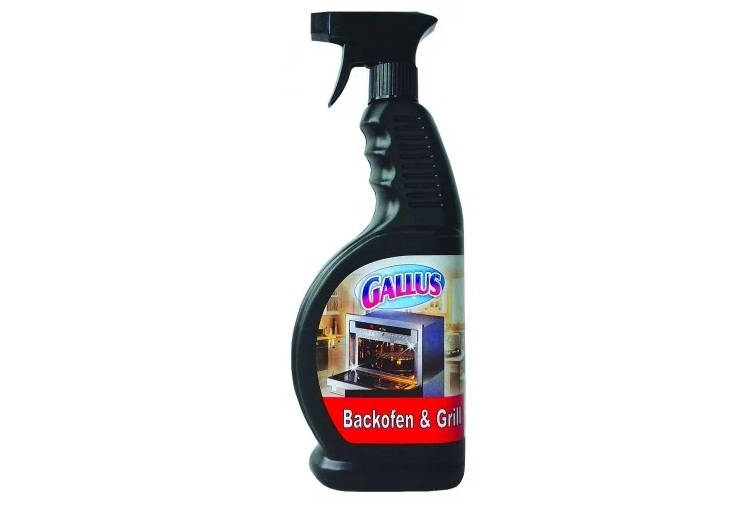
You can clean frying pans using household chemicals only in thick rubber gloves with cuffs, in a room with an open window.
Features of cleaning kitchen utensils made of different materials
To ensure that the frying pan retains its appearance and useful qualities after cleaning, carbon removers are selected based on the material used to make the pan.
How to clean aluminum?
Lightweight aluminum pans require very careful handling. The thing is that aluminum is a soft metal that easily deforms when pressed or actively rubbed. Under no circumstances should aluminum pans be scraped or cleaned with a wire brush or alkaline compounds.
A proven method for cleaning aluminum cookware is boiling with salt. Dissolve 200 grams of table salt in a large saucepan of water (at least ten liters). The frying pan is boiled in a saline solution for at least forty minutes, after which it is thoroughly rubbed with a sponge and detergent. It is important that the pan is completely covered with water during the boiling process.
Enamel
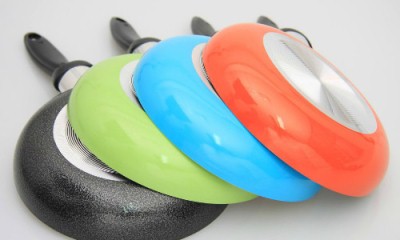 Frying pans, the inner surface of which is covered with enamel, withstands cleaning with acid, alkaline and salt compounds.
Frying pans, the inner surface of which is covered with enamel, withstands cleaning with acid, alkaline and salt compounds.
Metal brushes, sponges, and abrasive powders can damage the enamel. It is also always worth remembering that enamel cannot withstand sudden temperature changes (a hot frying pan should not be filled with cold water).
In order to clean heavy carbon deposits without damaging the integrity of the enamel coating, fill the pan with water and add 1 tsp. soda and 1 tsp. detergent. The resulting mixture is boiled for ten minutes, after which the carbon deposits can be easily removed from the walls of the frying pan with a soft sponge.
Cast iron
Heavy cast iron skillets are the easiest to clean. Cast iron withstands:
- mechanical cleaning with abrasives,
- metal brushes,
- heat treatment (pans are fired over fire),
- treatment with aggressive chemical compounds.
As an option, a cast-iron frying pan is heated over a fire for at least half an hour, after covering the bottom with a thick layer of salt or sand. Read more here.
Non-stick coating
A frying pan with a non-stick coating is suitable for use only if the internal protective coating is intact.
Therefore, when cleaning such pans It is very important to ensure that you do not get your hands on:
- metal brushes,
- abrasive powders,
- lemon acid,
- soda and acidic or alkaline household chemicals.
All these products corrode the non-stick coating, making the frying pan unsuitable for further use.
Fill the pan with water, add a few drops of vinegar.The resulting mixture is boiled for ten minutes, after which the carbon deposits are easily removed with a soft sponge.
Teflon
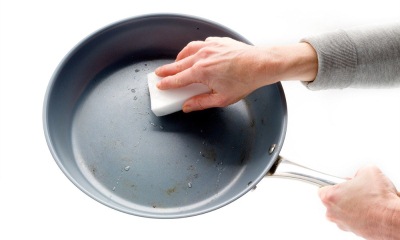 To preserve all the positive properties of a Teflon frying pan, Cleaning must be done with extreme care.
To preserve all the positive properties of a Teflon frying pan, Cleaning must be done with extreme care.
Teflon is a fairly soft non-stick coating that is very easy to damage with a sharp metal object. Teflon frying pans must not be cleaned with hard brushes, scrapers or abrasive powders.
Hot Teflon pans Do not use cold water to soak away dirt. Teflon-coated cookware is distinguished by the fact that regular care virtually eliminates the appearance of heavy deposits on the internal and external surfaces.
In cases where the use of dishwashing detergent does not lead to the desired result of cleanliness, to remove carbon deposits from the outside of the Teflon frying pan, wipe it with a soft sponge with a small amount of mustard powder.
Coca-Cola will help clean the inner surface. To do this, boil the carbonated drink in a frying pan for twenty minutes, after which the burnt fat can be easily removed with a soft sponge.
Ceramics
You can quickly clean a ceramic frying pan from carbon deposits, while maintaining the protective coating, subject to certain conditions:
- the ceramic surface is never cleaned with metal sponges, scrapers, or rough abrasives (only soft sponges and rags are allowed);
- Do not use products that contain chlorine, alkali or ammonia (these substances destroy the protective layer);
- Do not use soda to clean a ceramic frying pan (it leaves scratches and destroys the non-stick coating);
- You can wash and clean a ceramic frying pan only after the surface has completely cooled.
All ingredients are combined, brought to a boil, after which a dirty frying pan is immersed in the hot liquid. After two hours, not a trace of soot will remain.
What can't be done and why?
The rule of three “no” will help you clean the pan efficiently from soot, while maintaining its beneficial qualities:
 No metal sponges and brushes (they leave scratches and erase the protective non-stick layer).
No metal sponges and brushes (they leave scratches and erase the protective non-stick layer).- No abrasive powders (allowed only for cast iron products). Abrasives wear down the top layer of the pan, causing food to stick to the surface.
- No sudden temperature changes. Do not suddenly lower a hot frying pan into cold water. Stressful temperature changes destroy the protective layer, causing the frying pan to become unusable faster.
Adviсe
Before you start cleaning the frying pan from carbon deposits, It would be useful to remember some recommendations:
- When choosing a cleaning method, take into account the type of coating of the pan;
- First of all, we give preference to the most “natural” means at hand;
- using chemical compositions, we strictly observe the contact time of the surfaces of the dishes with the aggressive environment;
- We never clean frying pans without gloves (restoring the skin on your hands is more expensive).
Tips and recommendations for cleaning frying pans from the outside of soot are presented Here.
Conclusion
A shiny frying pan without soot is a reality.It is enough not to delay the cleaning process and use only proven, effective products.
